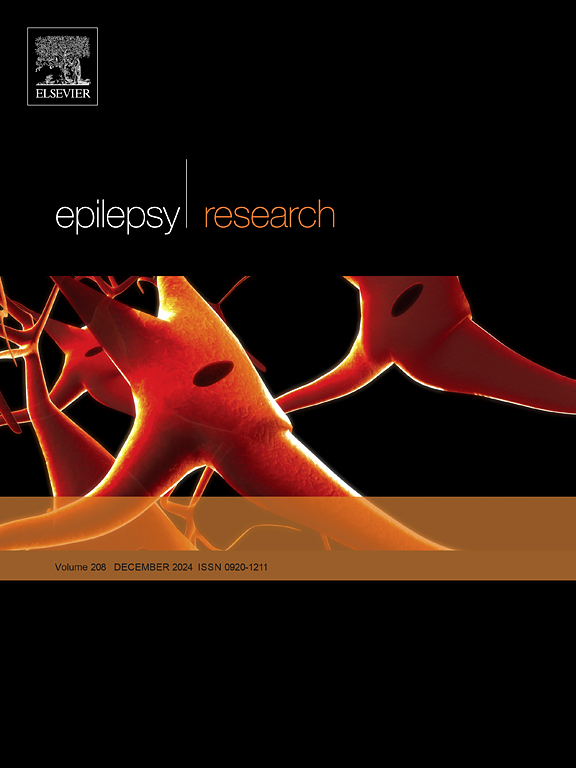丙戊酸治疗癫痫患者的潜伏性肾小管功能障碍
IF 2
4区 医学
Q3 CLINICAL NEUROLOGY
引用次数: 0
摘要
背景丙戊酸(VPA)诱发的范可尼综合征已有报道,特别是在有严重运动和智力残疾的患者中,肉碱缺乏被认为是一个可能的因素。潜伏性肾小管功能障碍(RTD)也在VPA治疗的癫痫患者中被注意到。我们的目的是通过检查尿液RTD标记物及其与临床变量的关系来评估接受和不接受VPA治疗的患者的潜在RTD。方法对147例儿童癫痫患者进行尿n -乙酰-β- d-氨基葡萄糖苷酶/肌酐(NAG/Cr)和β2微球蛋白/肌酐(BMG/Cr)测定。比较90例VPA治疗组(VPA组)和57例其他抗癫痫药物治疗组(非VPA组)的NAG/Cr和BMG/Cr。对VPA组RTD指标与临床变量进行单相关和多元回归分析。结果VPA组snag /Cr显著高于非VPA组,BMG/Cr差异无统计学意义。85例(94 %)VPA患者出现高或临界NAG/Cr (4.0 IU/g*Cr), 21例(23 %)患者出现高NAG/Cr(≥10.0 IU/g*Cr)。在VPA组中,NAG/Cr与游离肉碱(FC)、体重调整后的VPA剂量和VPA治疗时间显著相关。BMG/Cr与抗癫痫药物用量有显著相关性。多元回归分析显示NAG/Cr与FC显著相关。结论许多VPA患者存在潜在RTD, RTD标志物升高与肉毒碱缺乏症相关。医生应注意使用VPA治疗的儿童期癫痫患者的潜在RTD。本文章由计算机程序翻译,如有差异,请以英文原文为准。
Latent renal tubular dysfunction in patients with epilepsy treated with valproic acid
Background
Valproic acid (VPA)-induced Fanconi’s syndrome has been reported, especially in patients with severe motor and intellectual disabilities, with carnitine deficiency identified as a possible factor. Latent renal tubular dysfunction (RTD) has also been noted in patients with epilepsy treated with VPA. We aimed to evaluate latent RTD in patients treated with and without VPA by examining urine RTD markers and their relationships with clinical variables.
Methods
Urine N-acetyl-β-D-glucosaminidase/creatinine (NAG/Cr) and β2-microglobulin/creatinine (BMG/Cr) were evaluated in 147 patients with childhood-onset epilepsy. NAG/Cr and BMG/Cr were compared between 90 patients treated with VPA (VPA group) and 57 patients treated with other anti-seizure medications (non-VPA group). Single correlations and multiple regression analyses were conducted between RTD markers and clinical variables in the VPA group.
Results
NAG/Cr was significantly higher in the VPA group than in the non-VPA group, whereas BMG/Cr was not significantly different. High or borderline NAG/Cr (>4.0 IU/g*Cr) was seen in 85 (94 %) patients on VPA, and high NAG/Cr (≥10.0 IU/g*Cr) was seen in 21 (23 %) on VPA. In the VPA group, NAG/Cr was significantly correlated with free carnitine (FC), VPA dose adjusted for body weight, and duration of treatment with VPA. BMG/Cr was significantly correlated with the number of antiseizure medications. Multiple regression analysis showed that NAG/Cr was significantly correlated with FC.
Conclusions
Latent RTD was found in many patients on VPA, and elevated RTD markers were correlated with carnitine deficiency. Physicians should be aware of latent RTD in patients with childhood-onset epilepsy treated with VPA.
求助全文
通过发布文献求助,成功后即可免费获取论文全文。
去求助
来源期刊

Epilepsy Research
医学-临床神经学
CiteScore
0.10
自引率
4.50%
发文量
143
审稿时长
62 days
期刊介绍:
Epilepsy Research provides for publication of high quality articles in both basic and clinical epilepsy research, with a special emphasis on translational research that ultimately relates to epilepsy as a human condition. The journal is intended to provide a forum for reporting the best and most rigorous epilepsy research from all disciplines ranging from biophysics and molecular biology to epidemiological and psychosocial research. As such the journal will publish original papers relevant to epilepsy from any scientific discipline and also studies of a multidisciplinary nature. Clinical and experimental research papers adopting fresh conceptual approaches to the study of epilepsy and its treatment are encouraged. The overriding criteria for publication are novelty, significant clinical or experimental relevance, and interest to a multidisciplinary audience in the broad arena of epilepsy. Review articles focused on any topic of epilepsy research will also be considered, but only if they present an exceptionally clear synthesis of current knowledge and future directions of a research area, based on a critical assessment of the available data or on hypotheses that are likely to stimulate more critical thinking and further advances in an area of epilepsy research.
 求助内容:
求助内容: 应助结果提醒方式:
应助结果提醒方式:


